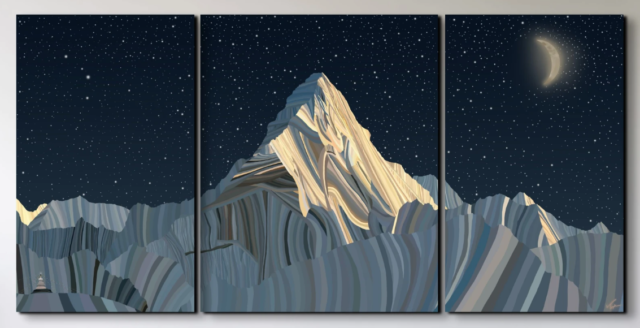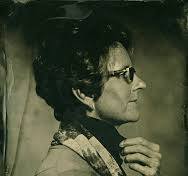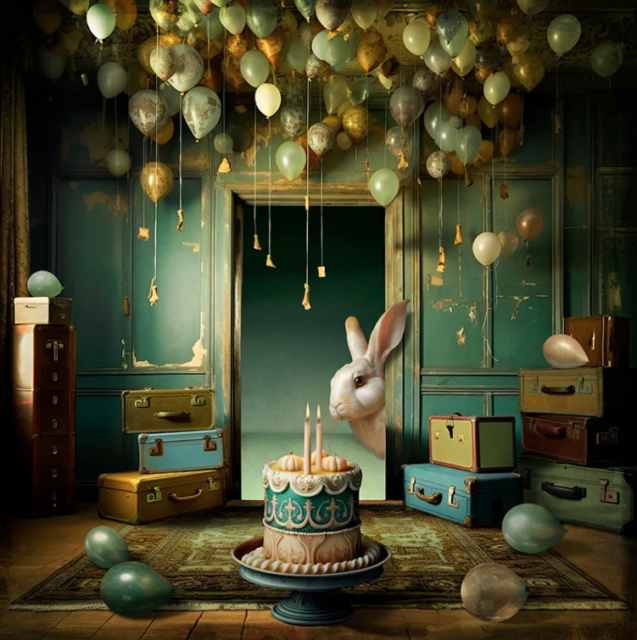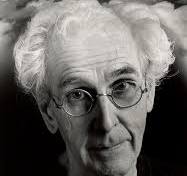
29 Jan Slate Gray Feb.: “From Darkroom to Digital”+ Bling!
Thursday, February 1, 2024, marks the second Telluride Arts’ Art Walk of 2024. Participating venues are open 5-8pm, hosting receptions to introduce new exhibits and artists. Throughout the month Slate Gray Gallery presents
Go here for more about Slate Gray.
Go here for more about Telluride Arts and Art Walk.
Please scroll down to read our email interview of Fill In.

On the surface the photographers – Topher Straus, Maggie Taylor and Jerry Uelsmann – and the jewelers – Petra Class, Barbara Heinrich and Timo Krapf – appear to have little in common – other than the obvious – they show their work at the same venue, Slate Gray. But scratch that surface and we find all six creatives are or were major innovators in their mediums. Then, pull back the curtain on their innovations, and we find hints of their personal stories and personality traits.
The photographers:
As recently 1985, New York’s revered Metropolitan Museum of Art did not have a separate photography department, just a cache of images collecting dust in a storage room of the print department. So baby, fine art photography has come a long, long way.
Telluride local and art aficionado Danny Winokur has had a long career in tech. He was an executive at Adobe leading customer experience for the flagship Creative Cloud business. Danny is now an independent advisor to the president of Adobe’s Digital Media business and remains on the front lines of technical innovations that serve to feed and enhance artistic impulses:
Artists have been using an array of evolving technologies as tools since the dawn of time: a chisel to carve stone, paper, cameras, lenses, film, and of course the explosion of digital technologies, like Photoshop, we’ve seen in recent decades. We see a microcosm of this evolution in the applications of technology by Uelsmann (film/darkroom), Taylor (compositing w/Photoshop), and Straus (digital painting in Photoshop). We’re now in the midst of an incredibly exciting time with an unprecedented pace of innovation in new digital tools for artists. Artificial intelligence (AI) is transforming how artists work, with applications including:
• Intelligent focus in cameras that can recognize eyes, animals, cars, and more;
• Generative AI image creation based on text descriptions with services like Adobe Firefly, Dall-E, and Stable Diffusion;
• Selection and masking features that understand the different components of an image and allow those bits and pieces to be separately edited,
• Generative fill/expand that can replace parts of an image or expand beyond its boundaries based on text descriptions.
We’re still in the early days of these artistic applications of AI and can expect it to be a sustained and disruptive force for creativity. Artists are experimenting with all the new ways they can realize their visions. It will be fascinating to see the work of those who are destined to become creative successors in the tradition of Uelsman, Taylor, and Straus. They are already hard at work inventing techniques to create exciting new art using AI and other emerging technologies.
Danny Winokur’s astute observations set the table for further details about the work of the three fine art photographers in the group show at Slate Gray titled “From Darkroom to Digital,” each one a trailblazer.
Topher Straus:

Topher Straus, credit: Mastrius
Out of the gate, Topher Straus was predisposed to a career in fine art. It was is in his cultural DNA:
“My great grandfather immigrated to Leadville Colorado during the silver rush from the kingdom of Bavaria Germany in 1854. He opened a dry goods store which would later become one of our nations largest department stores: The May Company. His daughter and my grandmother, Florene May, used her wealth and knowledge of fine art to acquire a fantastic collection, including Picassos, Matisses and Miros.
“I grew up visiting Florene in her New York apartment surrounded by these masterworks. I would like to believe the colors and lines in these extraordinary paintings shaped the work I am creating today. Eventually Florene donated those paintings to New York’s Museum of Modern Art and The Met. Her generous sense of giving and community, along with her deep understanding of color and shape, also greatly influenced me as an adult.”
But it was performing art, not fine art, that first captured Topher’s heart and talent:
“I envisioned myself as a film director, but once I obtained that goal I realized it wasn’t what I wanted. The life just did not speak to me, nor would I ever be able to obtain my vision of success because there was always the next level. Enough would never be enough.”
In fact, becoming a fine artist was the furthest thing from Topher’s young mind:
“I was forced into fine art. In high school, I was an athlete and a successful actor, having appeared in over 350 commercials and winning a Heartland Emmy. I wanted to be a filmmaker, but in order to study film at Syracuse University I had to take an art course during my freshman year.”
From that requirement, making art became something immensely personal for Topher, who would use the canvas to express things he did not know how to express verbally, the tragedy of 9/11 or gentrification in Africa among them:
“No more than 15 people would see my over 70 acrylic paintings over the next two decades. I wasn’t ready to share my vision with the world. It wasn’t until going through a difficult divorce and the desire to be a role model for my son, Oliver Viking, that I would open up my heart and share my work. It was 2019 when I had my first show. And now I feel blessed to be where I am and understand things happened when they needed to. If I stop and take a look, many moments conspired to put me where I am at today.”
To make his art, Topher starts with a photo, often based on a personal experience, then he turns to his computer and stylus to “paint” the image.
“I choose to focus on the true colors I see in nature and base my photos off what I believe to be an iconic perspective. With my film experience, frame and composition are clearly very important. The scale of my work is generally very big. Often people who view an original of about 45 x 90 inches feel like they are in a frame of film.”
Topher Straus lives life shooting for the moon. Case in point, the man’s creative influences: Matisse, Picasso – and award-winning director Robert Altman for whom Topher once worked:
“In my art, I try to tell a story – create a tapestry of stories – the way Bob taught me.”
At the end of the day Topher’s spare approach to his principal muse, Mother Nature, reflects the signature economies of all three titans. His art comes down to minimal, yet essential abbreviations of his worlds, natural and urban, devoid of clutter, those frontiers of joy opening up vistas we may have looked at, but not really seen.
“A large part of my art is the first step, the actual journey, experiencing nature in person – or nature in motion as it were. Whether it’s the delicate eyelashes of an elephant up-close or the continually changing hues around me, I’ve learned that all the parts create the magical whole…Growing up in Colorado and hiking and skiing the mountains as a youth, I naturally became passionate about the outdoors and preservation. It’s no coincidence I chose the iconic vistas of America’s national parks as my first major focus.”


The Ride, Topher
For a deeper dive into Topher’s art and life, check out his answers to TIO’s qs:
TIO: You were fortunate to grow up surrounded by masterpieces – at least when you visited the home of your grandmother Florene May, who collected Matisse, Picasso and Miro, among other art world titans. Sum up how befriending their work influenced your art.
TS: Being surrounded by these paintings, living with them, I was directly influenced by the color and composition of these masters, especially Matisse. His work has a very direct influence on the way I interpret nature.
TIO: Your art starts with a photo, generally of a scene fashioned by the star of all your shows: Mother Nature. Image in hand you then turn towards your computer and stylus to “paint.” Originally though, you worked in acrylic. Why the switch to digital?
TS: I think my switch to digital was not only influenced by my experience in technology, working for companies like Apple and in electronic arts, but also by the moment, the times we are living in. The line between our augmented reality and our actual reality is quickly being blurred. I also love the forgiveness of digital and the amount of play I have when using it. I love that it is a relatively new medium and that I am constantly exploring and pushing the boundaries of what it was intended to do.
TIO: Some would say a piece created digitally is not fine art because the work is one cool remove from the artist himself who uses “tricks” to create a finished piece. Your response?
TS: I don’t agree with this at ALL. EVERY painter and artist uses “tricks” to create a finished piece – that is in the process we are taught. Whether it is using transfer paper and a reference image to underpainting to using different amounts of paint to create the illusion of texture or perspective. Art is meant to incite emotion – as artists, we should always challenge what is art and push boundaries. My digital techniques are constantly evolving, and to me, the evolution of using technology in art is very natural in our hi-tech world of today.
TIO: For your third Slate Gray Telluride show, your work will be on display next to images by Jerry Uelsmann, widely considered the forefather of Photoshop, and that of his former wife, the equally innovative and imaginative Maggie Taylor, who also works digitally. How do you feel about hanging out (literally and figuratively) with such celebrated talents?
TS: What an honor to be shown with such innovators in the medium of my choosing! And what a great followup question to the one about “tricks”. Uelsmann and Taylor are exceptional fine artists who have paved the way for the future of digital artists and it is quite an honor to be shown alongside them. Although our work is very different in the interpretation of the world around us through the digital perspective, the ties that bind us will create a unique show.
TIO: Describe your Big Telluride Image for this show. What else will your fans see on display?
TS: Telluride has quickly become my muse! The inspiration from each adventure I have here leads to the painting I’ll be presenting the following year. I feel that some of my best work from Colorado is of Telluride. For “The Ride,” my newest Telluride painting, I literally looked out the gondola after spending the morning at Slate Gray Gallery meeting collectors, on my way up to get a few turns in. As I looked at the city and the majesty of the view from above, I knew that would be my 2024 painting for the show.
I’m also thrilled to be debuting the “Original of Everest,” a 10′ by 5’ triptych. It will be amazing to see this piece in person. The view will envelop you. The painting captures epic mountain majesty. We will also feature the Telluride Special Edition from my original 2022 Telluride painting, which sold out of the Limited Editions. This is a very unique and special opportunity.
Maggie Taylor:

Maggie, courtesy Main Media Workshops.
In the rarefied universe of fine art photography Maggie Taylor is a super nova. Over the years, she has produced a body of work that infuses the ordinary and mundane with a sense of magic and mystery.
Maggie Taylor grew up in the 1960s/1970s, when social commentary was the name of game in the work of Pop artists such as Andy Warhol. Her images, however, are less social commentary and more personal statements, often, though not always, with a feminist cast. By means of exacting realistic techniques, Maggie manages to make her improbable, dreamlike, and fantastic vision plausible and compelling – and in the process, throw viewers more than little off balance.
In her studio, Maggie has drawers and shelves filled with all kinds of objects and pieces of text, plus Daguerreotype or Tin Type portraits of unknown subjects from the 19th century. The artist choreographs the detritus of her life indoors before taking the items outside into her yard to photograph them with an old-view camera in natural light.
An avid gardener, Maggie also finds inspiration as well as actual material to scan when outside. She then builds stories around those images by combining her own photographs and scanned objects to create digital collages in Photoshop. In the end she creates the final product from as many as 200 layers.
A book entitled “No Ordinary Days” surveys Maggie Taylor’s work from 1998 – 2012.
“In her digital photomontages Maggie Taylor opens for us multitude of doors into a seductive, richly nuanced dream world. However unlike many who explore the cross-breeding of imagery that digital systems enable, Taylor creates a microcosm with deep ties to the past. Not just the immediate past that becomes an inevitable aspect of each photographic exposure we make, but also the distant past of the 19th and early 20th centuries,” wrote A.D. Coleman in an essay about the book.
“Often when people think about using the computer to make art, they mistakenly think that it is an easy solution or a very quick process. In my experience, using the computer is slower than working with a camera and film. I go back again and again to the images and refine and improve them. I only make about 10 to 15 images a year and I can be working on one image for a few weeks or even a month. That said, for me, both computer and camera are great ways to document as well as transform reality,” explained the artist.
In other words, Maggie s technically brilliant and unapologetically enigmatic, her humorous images reminiscent of Magritte or Dali, though they explore deeper archetypes.

The Surprise, Maggie

It’s My Party, Maggie.
Maggie Taylor holds a B.A. in philosophy from Yale University and an M.F.A. in photography from the University of Florida and is widely collected.
Her work hangs in major museums around the country including The Center for Creative Photography, Tucson; The George Eastman House, Rochester; The High Museum, Atlanta; Museum of Fine Arts, Houston; Ogden Museum of Southern Art, New Orleans; The Art Museum, Princeton University; The Fogg Art Museum, Harvard; The Santa Barbara Museum of Art, Santa Barbara.
Maggie’s photographs also travel internationally and have been shown in France, Germany, China and Mexico.
Jerry Uelsmann:

Jerry Uelsmann, courtesy The New York Times.
Jerry Uelsmann began producing his dramatic photomontages in the 1960s, black-and-white images that are not at all black and white, rather unsettling alternatives to naturalism. These surrealistic, hyper, super or anti realities – call them what you like, the labels are just variations on a theme – amount to a psychic topography developed from things that happened at the fringes of Uelsmann’s consciousness.
Clues to the meaning of the work, however, can be derived from artist’s symbolic vocabulary, which remained surprisingly consistent over the years: nature and culture cross boundaries when interiors meld with exterior landscapes. Figures levitate and fly as in dreams, free of gravity. Monumental hands, a classic element in Surrealist photography of the 1920s and 1930s, appear everywhere. Other bizarre, even grotesque Surrealist motifs include disembodied human parts, humans merging with trees, rocks and water, animal, vegetable and mineral blending and intertwining, the stuff of the shadow world. Universal archetypes such as house, tree, sky and water, are all re-contextualized, forcing us to confront them like children, with wonder and for the first time.
Confronted with these images, viewers are forced into an internal dialogue between what they know intellectually about photography – the medium depicts things as they are, right? – and what they are asked to confront. The inventive consciousness of Jerry’s viewers then becomes another element in the picture frame. Describing the work, scholars have drawn analogies to lyrical poetry, because the artist’s elusive work clearly falls into the narrative, as well as the visual tradition.
Content notwithstanding, composition in an Jerry Uelsmann is also a subject worth exploring. The man was considered a virtuoso in the the darkroom, where he pioneered and was continually perfecting new bravura developing techniques. For starters, on three or more of the eight enlargers in his darkroom, the artist combined parts or all of two or more negatives, which he then burned and dodged (exposed sections to more or less light) to make his final, seamless black-and-white prints.
Jerry talked about his unique way of working as “in-process” discovery or “post visualization,” an idea that turns Ansel Adams’s notion of pre-visualization on its head.
Pre-visualization demands that a photographer see in his mind what he wants to create at the moment of exposure. Jerry’s theory allows photographers to rethink an image at any point in the photographic process, to imagine “what if.”

Uelsmann, Untitlled, 1969 (Floating Tree)

Uelsmann Untitled, 1968 .(Symmetrical Rock and Barn Blue Tone)
Jerry Uelsmann was born in Detroit, Michigan in 1934. In the early 1950s, he attended Rochester Institute of Technology, where Minor White was among his teachers and a major influence. White is widely quoted as saying the goal of a serious photographer – read fine art, not point and shoot – is to get from the tangible (what things are) to the intangible (what else they are) to create visual metaphors.
Jerry’s work is in the permanent collections of the Metropolitan Museum of Art, and the Museum of Modern Art in New York; the National Gallery of Art in Washington, D,C; the Victoria and Albert Museum in London; and other major museums around the world.
The jewelers (see related story).


Sorry, the comment form is closed at this time.